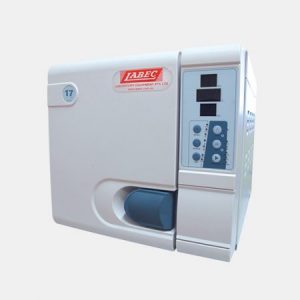Understanding Autoclaves – Classes: B, S, and N
Advanced Sterilization for Both Hollow and Solid Instruments
Class B Autoclaves:
- Capable of sterilizing both wrapped (e.g., in a pouch) and unwrapped instruments, regardless of complexity.
- Suitable for solid and porous instruments as well as complex hollow body instruments such as surgical handpieces and endoscopes.
- Commonly used by dentists, plastic surgeons, day surgeries, medical surgeries, tattooists/body piercers, veterinarians, hair and nail salons.
Class S Autoclaves:
- Designed to sterilize single and double wrapped (e.g., in a pouch) solid instruments, porous products, and small parts.
- Can sterilize simple hollow body instruments such as scissors and clamps.
- Recommended over Class B autoclaves when sterilization of complex hollow body instruments is not required.
Key Features of Class B & S Autoclaves
- Class B&S autoclaves are the most advanced models, capable of sterilizing both hollow and solid instruments, whether wrapped, unwrapped, solid, porous, or complex hollow body instruments like handpieces and endoscopes. They are typically used in surgical environments and other medical and healthcare settings. These models offer a choice of 7 programs, including a thermal vacuum drying program.
- Class S autoclaves share similarities with Class B in their ability to handle wrapped, unwrapped, solid, and porous instruments/products. However, they are not suitable for sterilizing complex hollow body instruments—only simple hollow body instruments like scissors or clamps. These models come with more basic functions compared to Class B.
Class N Autoclaves:
- Suitable for sterilizing “naked” unwrapped, solid instruments, glassware, and liquids.
- Does not include a vacuum drying cycle and will not penetrate through porous materials.
Choosing the right autoclave depends on the specific needs of your practice or facility. For environments requiring the highest level of versatility and capability, Class B autoclaves are the best choice. For less complex needs, Class S autoclaves provide reliable performance without the ability to sterilize complex hollow body instruments.
Choosing the Right Autoclave for Your Sterilization Needs
When it comes to autoclaving liquids, the STE-23-K model is a suitable option, provided that the liquids are not agar or broths. To prevent any potential boil-over or spillage, it’s important to place the bottles in a watertight tray.
For sterilizing solid instruments and glassware, the N class autoclave is a practical choice. However, it’s worth noting that this type of autoclave does not include a drying cycle, so the glassware may come out wet and with some drips.
S and B class autoclaves are more advanced and designed for instrument sterilization. These models draw a vacuum both before and after the sterilization process. The S class is ideal for solid instruments, while the B class is suited for hollow instruments. Both S and B class autoclaves can handle wrapped or unwrapped instruments.
Using agar or broths in small benchtop autoclaves can be problematic. These substances can become entrained in the steam, which then condenses inside the pressure lines and causes blockages. Such blockages are not covered under warranty when repairs are needed.
To avoid these issues, we recommend using the Shinva 45N model for your sterilization needs. Contact us for more information.

